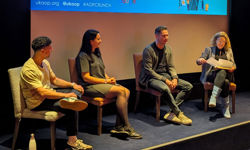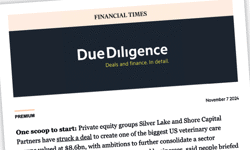At the time of typing, it is 131 days since the launch of Newsstand on the iPad, iPhone and iPod touch - and 131 days is all it's taken for a tablet computer previously best known for the launching of some surprisingly explosive birds at some unsurprisingly grumpy pigs to be hailed as the saviour of the publishing industry.
The iPad - released nearly two years ago as you read this article - is the device that has finally made the digital edition valid in the publishing industry.
The likes of Zinio can rightly claim to have blazed its trail but any true adoption of the digital edition could and would only come when it was freed from the desktop, page corners no longer needing to be dragged and dropped with the sharp end of a cursor.
Now the digital edition sits proudly atop a smooth, glass rectangle, finally portrait, not landscape. Pages are not only turned exactly as you would their paper equivalent but, with the opportunity to embellish the page with rich multimedia, they can be tapped, swiped and played. The experience is both familiar and suddenly enriched - is there any wonder that Newsstand has been such a success with publishers and readers alike?
So Newsstand - and the increasing amount of newsstands you'll find on other non-iOS devices, whether smartphone, tablet, desktop or e-reader - is here to stay.
No longer a financial footnote to the bottom of a topsheet, this February's digital ABC figures prove there are real revenues out there with digital editions subscriptions making up an increasingly noteworthy percentage of a multi-channel whole.
This is a proper, budgeted business - and that means all the publishing challenges that distribution, subscription, advertising, marketing and editorial has had since the magazine business began.
Newsstand has had a massive effect on the company I work for, Future Publishing. We embraced the launch of Newsstand like no other publisher, launching 65 standalone digital replicas on Day One of Newsstand way back on October 12th, 2011. Our first month on Newsstand generated well over $1m in gross revenues and since October, we've sold over 430,000 digital issues or paid copies. We’re now selling more than 150,000 paid copies per month.
We decided on such a company-wide tactic based not only on observing the sharp rise in revenues of our long-standing Zinio business after the launch of iPad, but on our experience with our premiere gadget lifestyle magazine, T3.
Launched on the iPad in October 2010 on the WoodWing platform and one of only four magazines worldwide to launch magazine subscriptions in Q1 2011 (a precursor to Newsstand's subscription functionality), T3: The iPad Edition is the UK's number one, top-grossing iPad magazine.
Almost fundamentally opposed to a flat digital replica, T3: The iPad Edition is interactive to its core, featuring scrolling text, 360 degree panoramas, integrated video, scrolling editorial and HTML5 ad solutions created not by an agency but in-house by a bleeding edge editorial and design team.
T3 as a brand was the perfect fit for iPad - good-looking, cutting edge, fast moving, about gadgets (!) - and the shop window that is Newsstand has only accelerated its success with readers and clients alike. As of January 2012, the iPad edition averages over 14,000 monthly sales as part of a digital edition total of more than 21,000.
So in our page turners and T3, at Future we have both scale and specialism, quantity and quality. But which one makes for the 'best' digital edition - the digital replica or the interactive edition? Which has long-term appeal to the needs of the changing audience a rapidly rising install base will bring? Which has least impact on your existing teams and workflows? Which will translate to the forthcoming iPad 3 and which will be 'vanilla' enough to port to the Kindle Fire, Nook and any other device currently in R&D?
Let's look at the cases for and against.
DIGITAL REPLICAS
The case for
* A digital replica is just that - a flat version of an existing print title with some limited interactivity on top (hyperlinks, some search capability etc) - and that means it's achievable with no massive impact on your teams. Third-party solutions such as Zinio, PixelMags, Exact Editions and PocketMags all exist to get you on device(s) or you can develop your own software as we have at Future with FutureFolio.
* Achievability means you can confidently consider a scale proposition rather than simply cherry picking a single magazine from your portfolio. Workflows and process is the key to this (tip: hire a good Project Manager) but if you've done it in print and/or done it for Zinio, you can do it here.
* With no reworking required or upheaval necessary, digital replicas are a quick, effective 'flag in the ground' for you not only to get your business on device but discover what your readers want. Your platform's analytics solution can be combined with your download figures to discover just who's reading your title and where. It's then up to you to ask why.
* The digital replica not only services iPad but iPhone, Android, desktop and e-Reader. On every device no matter what size, the combination of original page aspect ratio and familiar page-turning navigation means there's no manual needed here - and the larger and more A4-friendly your device, the more the digital replica just makes sense…
The case against
* To continue that last point, the smaller and less A4-friendly your device, the less of a natural fit the digital replica can't help but feel. Seven-inch devices tend to be tall but narrow, with page widths reduced so far to mean 'pinching and zooming' is a matter of course on every page. Not an issue on the generously-sized iPad but if looking to place editions on other devices, then a text view solution is mandatory.
* Digital replicas are not simply a bunch of final PDFs bundled on device. PDFs require repro work, whether removing a covermount flash, altering spot colours and foil effects or just upgrading your print PDF to its digital variant. Third parties can deliver this as can your own repro department but it will need consideration every month.
* While certainly cheaper than posting its paper equivalent, you will need to budget to fund the actual downloads - and that's whether it's a paid-for issue or free sample. It's a necessary expense and hardly a surprise, but do your homework / sums.
Summary
The digital replica can be a smart, effective, profitable first step and with only minimal changes to workflows, represents the best way to deliver an entire portfolio to any device on a global scale. The snag? A flat page-turning experience might not be the answer for ad-driven titles reliant on creative solutions or a long-term solution for your big brands with bigger reader expectations - but while you're considering an interactive edition, why not test the waters with a product with a digital replica?
INTERACTIVE EDITIONS
The case for
* An interactive edition is just that - a version of your magazine with added interactivity, including video, galleries, live feeds and developer-driven solutions - and as with digital replicas, it's achievable. Third-party publishing solutions such as WoodWing, Adobe Digital Publishing Suite and Mag+ all exist to get you on a variety of devices. Again, you can also develop your own software as we did at Future with FutureFolio.
* As a look at T3, Wired, GQ or our newest interactive edition Guitarist Deluxe will show, it's as luxurious as its host device. Increasingly loved by clients and readers alike, it offers the same rich, tactile experience as the apps it sits alongside.
* As alluded to above, interactive editions work for bigger brands. Not only is it a obvious fit, larger brands not only have the larger teams required to deliver the bespoke design solutions required but also tend to have the multiple channels - and thus multi-channel content - necessary to 'fill' an interactive edition.
The case against
* Whilst the analytics, video capabilities and trackable hyperlinks make the interactive edition more agency friendly 'out of the box', it's currently unlikely your clients will be set up to provide ad copy. Be careful what you wish for - unless you plan in resource, you might be designing the ad copy that makes your magazine late on sale.
* Software platforms will enable you to move your work to other devices - T3 has just successfully debuted on Android using WoodWing whilst Wired has just debuted its Adobe edition on Nook and Kindle Fire. However, vastly different screen sizes and aspect ratios means your iPad edition won't automatically transfer to another tablet without additional design work.
* Finally, pricepoint. Whilst the additional staff, design, IP and sheer effort that fuel an interactive edition might unlock additional ad revenues and improved conversion rates, a higher degree of interactivity doesn't necessarily command a higher pricepoint.
Summary
Interactive editions: they look great, they sound great and they're full of great content that readers love. However, whilst they're possibly the digital edition most fitting for the future, the present shows that unless you have the brand, the set-up, the clients, the content and the audience, the lack of a premium pricepoint model means only the future-proof should be 'upgrading' from digital replica. But if you can? You should!
CONCLUSION
So which one is best? After 131 days, the only logical response is 'both'.
Digital replicas are a comparatively low-risk way to launch your titles on Newsstand. They may pale in comparison to the bells and whistles of the more overt interactive editions but with little additional budget or effort, they enable you not only to get on device quickly but to start the conversation with your audience on what they want to read and why.
Interactive editions enable you to continue that conversation, using the tools at hand to create the content your audience demands and the environment your clients desire. At these early days of tablet ownership, any interactive edition requires investment but with shop windows such as Newsstand, the rising install base of tablets and the launch of a certain iPad 3, it’s not so much as preparing for the future but preparing for tomorrow.
Both digital replicas and interactive editions have pros and cons, risks and challenges but also rewards and learns - and one other thing. Future's research shows that 90% of its readers on Newsstand are new readers, whether it's digital replica or interactive edition, with only 20% being based in the UK. These are new audiences in new lands and with new needs.
The question shouldn't be which one you do. It should be which one do you do first.










